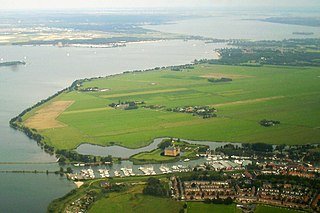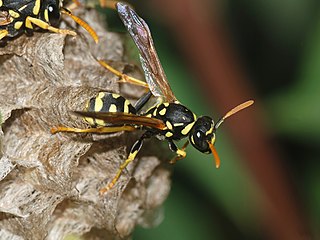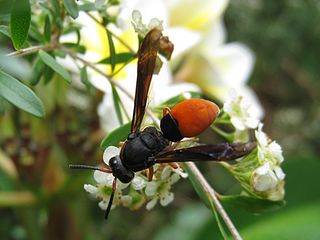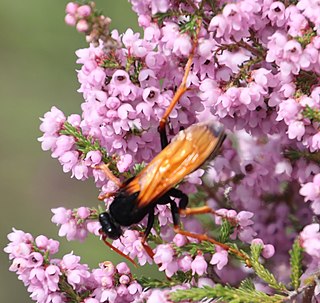
Muiden is a city and former municipality in the Netherlands, in the province of North Holland. It lies at the mouth of the Vecht and is in an area called the Vechtstreek. Since 2016, Muiden has been part of the new municipality of Gooise Meren.

Carpenter bees are species in the genus Xylocopa of the subfamily Xylocopinae. The genus includes some 500 bees in 31 subgenera. The common name "carpenter bee" derives from their nesting behavior; nearly all species burrow into hard plant material such as dead wood or bamboo. The main exceptions are species in the subgenus Proxylocopa, which dig nesting tunnels in suitable soil.

Polistes is a cosmopolitan genus of paper wasps and the only genus in the tribe Polistini. Vernacular names for the genus include umbrella wasps, coined by Walter Ebeling in 1975 to distinguish it from other types of paper wasp, in reference to the form of their nests, and umbrella paper wasps. Polistes is the single largest genus within the family Vespidae, with over 200 recognized species. Their innate preferences for nest-building sites leads them to commonly build nests on human habitation, where they can be very unwelcome; although generally not aggressive, they can be provoked into defending their nests. All species are predatory, and they may consume large numbers of caterpillars, in which respect they are generally considered beneficial.

Vreeland is a village in the Dutch province of Utrecht. It was a part of the former municipality of Loenen. Since 2011 it has been part of the new formed municipality of Stichtse Vecht. It is located on the river Vecht, about 2 km north of Loenen aan de Vecht. It received city rights in 1265. In 2015, the village celebrates the 650th year of its foundation.

The Australian hornet is not a true hornet, it is a type of potter wasp or "mason wasp", is a vespid native to the Australian states and territories of the Australian Capital Territory, New South Wales, Northern Territory, Victoria, Queensland and Western Australia.

Abispa is a genus of large Australasian potter wasps belonging to the subfamily Eumeninae. The genus was first described in 1838 by Thomas Livingstone Mitchell.
Alphamenes is a small neotropical genus of potter wasps that currently contains 7 species, it was named by the Dutch entomologist Jacobus van der Vecht in 1977.

Anterhynchium is an Afrotropical, Indomalayan, Australian and Palearctic genus of potter wasps. As in many species of wasp, female wasps defend against predation using a modified ovipositor to sting predators. Like some other wasps in the Vespidae family, male wasps can produce a "pseudo-sting" with two sharp spines on either side of their genitals; however, unlike in the females, this "sting" is venomless.

Delta is an Old World genus of potter wasps with species predominantly distributed through tropical Africa and Asia. Some species are present in the Palearctic region, and a few have been introduced in the Nearctic and Neotropical regions. The members of this genus have a long metasomal petiole, like members of the genera Eumenes and Zeta.

Ropalidia is a large genus of eusocial paper wasps (Polistinae) in the tribe Ropalidiini distributed throughout the Afrotropical, Indomalayan and Australasian biogeographical regions. The genus Ropalidia is unusual because it contains both independent and swarm-founding species. Ropalidia romandi is one of the swarm founding species, meaning that new nests are founded by a large group of workers with a smaller number of inseminated females, while Ropalidia revolutionalis is independent-founding, meaning that each nest is founded by a single foundress.

Pseudabispa is an Australian and Papuan genus of potter wasps containing 5 species, one of them subdivided in 4 subspecies.

Stichtse Vecht is a municipality of the Netherlands and lies in the northwestern part of the province of Utrecht.

Abispa splendida is a species of wasp in the Vespidae family.
Abispa ruficornis is a species of wasp in the Vespidae family.
Van der Vegt is a Dutch toponymic surname meaning "from/of the (river) Vecht". For most families, "Vecht" refers to the Overijsselse Vecht. At least one family is known to be named after the Utrechtse Vecht. Among variants are Van der Vecht and Van de(r) Vegte. People with the surname include:
Labus is an Indomalayan genus of potter wasps. It contains the following species:

Hemipepsis is a genus of large pepsine spider wasps found throughout the tropics. They are commonly known as tarantula hawks. Hemipepsis wasps are morphologically similar to the related genera Pepsis and Entypus, but distinguishable by the pattern of wing venation. In South Africa 18 plant species from three plant families, the Apocynaceae, Orchidaceae, and Asparagaceae subfamily Scilloideae are pollinated exclusively by Hemipepsis wasps.
Jacobus van der Vecht, nicknamed Jaap, was a Dutch entomologist who specialised in Hymenoptera, especially those of the East Indies and New Guinea.
Van der Vecht's gland or Van der Vecht's organ is a gland which is located in an area of modified cuticle on the rearmost gastral sternite of female wasps. This gland secretes chemicals which are important in the determination and maintenance of the hierarchy of groups of eusocial wasps and are used in the defence of the nests in others. In the Asian giant hornet the Van der Vecht's gland is used to scent mark hives of honey bees to attract other members of their colony to cooperatively attack the hive; the only known case of the gland's use to scent mark a food source. In the cleptoparasitic paper wasp Polistes semenowi the female usurps the host foundress, usually Polistes dominula and uses an enlarged Van der Vecht's gland to produce large quantities of hydrocarbons and to control the host workers, and even sometimes the host foundress. The gland was discovered by, and named in honour of, the Dutch entomologist Jacobus van der Vecht.













